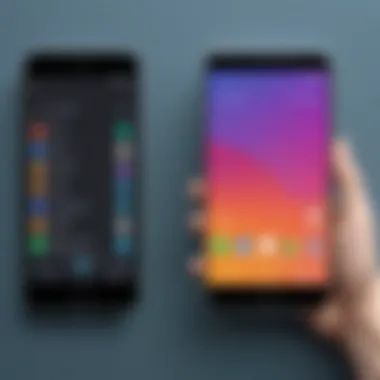Exploring the Best User-Friendly Smartphones


Intro
The exploration of user-friendly smartphones reveals a landscape dominated by devices designed for both the tech-savvy and those new to technology. As the smartphone market continues to evolve, understanding the features that define usability and accessibility is crucial. This article aims to provide a deep dive into those traits that make smartphones user-friendly. By analyzing specifications, benefits, and user experiences, we can guide tech enthusiasts and IT professionals in selecting devices that meet their unique preferences.
User-friendly smartphones are not only about advanced technology; they emphasize how easy it is to operate, navigate, and enjoy all functionalities. Given the rapid advancement of smartphone technology, it has become vital to separate genuinely user-friendly devices from those that merely appear so on the surface.
In this article, various models will be examined to highlight key aspects such as hardware specifications, software features, and the overall user experience. Moreover, we will assess market trends and innovations that pave the way for future developments in smartphones. With insights catered to industry professionals, enthusiasts, and casual users, this exploration serves as a comprehensive guide to understanding what defines the best user-friendly smartphones in today’s competitive marketplace.
Defining User-Friendliness in Smartphones
User-friendliness in smartphones is a multifaceted concept that plays a vital role in determining the success of a device in a crowded market. As technology progresses, more users expect devices that not only perform tasks, but do so without a steep learning curve. For IT professionals and tech enthusiasts alike, understanding what makes a smartphone user-friendly can aid in selecting devices that meet varying levels of expertise.
One of the core elements of user-friendliness is intuitiveness. A user interface must be designed in a way that allows individuals, regardless of their technical skills, to navigate without confusion. This includes clear menus, well-placed icons, and thoughtful prompts that guide the user rather than overwhelm them.
The benefits of focusing on user-friendliness extend beyond simple navigation. A user-friendly smartphone enhances productivity, fosters user engagement, and minimizes frustration. This is particularly crucial in professional settings where efficiency is paramount. Users are more likely to adopt technology that they find easy to use, leading to higher satisfaction rates and fewer support requests.
Considerations also come into play when defining user-friendliness. For instance, the target user demographic must be considered. Novice users may prioritize different features compared to seasoned tech users. Moreover, accessibility features must not be overlooked, as they ensure that those with disabilities can use smartphones effectively.
A user-friendliness focus ultimately leads to greater adaptability in technology use.
In summary, defining user-friendliness in smartphones is essential for aligning device features with user expectations. By delving into the specifics of what constitutes a user-friendly device, readers will better appreciate how form and function can coexist to meet all sorts of user requirements.
Core Characteristics of User-Friendly Devices
User-friendly devices share certain characteristics that make them appealing to a broader audience. These elements include:
- Simplicity: Easy navigation enables users to find features quickly without getting lost.
- Consistency: A consistent interface across apps helps users build familiarity.
- Customization: Options for personalization enhance the overall user experience.
- Feedback: Providing appropriate feedback, whether through haptic responses or visual cues, reassures users about their actions.
Each of these characteristics contributes to a more seamless interaction, elevating the appeal of the device overall.
Importance of Usability in Technology
Usability is a cornerstone of any technology product, particularly smartphones. It encompasses the ease with which users can achieve their goals with the device. With the rapid evolution of features and applications, usability becomes increasingly vital. A smartphone that is challenging to use can quickly become obsolete, regardless of its technological advancements.
Emphasizing usability ensures that all users—regardless of their tech-savviness—can engage with the device productively. This is particularly significant in a world where many tasks are being shifted to mobile platforms. A strong usability focus can lead to:
- Enhanced user engagement
- Improved functionality of both hardware and software
- A broader user base, including individuals who might previously have struggled with more complex technologies.
Key Features to Consider
In the landscape of user-friendly smartphones, understanding key features is paramount. These elements not only define the user experience but also greatly impact the usability of devices. For IT professionals and tech enthusiasts alike, evaluating these features can lead to more informed purchasing decisions, enhancing both engagement and satisfaction with the chosen device.
Intuitive User Interface
The user interface (UI) plays a critical role in how individuals interact with their smartphones. An intuitive UI can significantly minimize the learning curve for new users, allowing them to navigate applications and settings with ease. This feature is essential because it directly affects usability and overall user satisfaction. A smartphone with a well-designed interface ensures that even the most complex functions can be accessed quickly.
For instance, iOS, found in Apple's devices, features a straightforward layout that engages users without overwhelming them. In contrast, Android offers more customization options, catering to those who enjoy tailoring their experience. When assessing UI, consider:
- Clarity of icons and menus
- Ease of navigation
- Availability of tutorials or help sections
Accessibility Features
Accessibility features are crucial for making smartphones usable for all individuals, including those with disabilities. Modern smartphones often come equipped with various tools to assist users, ensuring that technology is inclusive. Features like voice recognition, screen readers, and adjustable text sizes make a device more versatile.
The importance of these features cannot be overstated. They empower all users to interact with their devices confidently. When evaluating accessibility, look for:


- Voice control options
- High contrast display settings
- Customized touch responses
Battery Life and Performance
Battery life is a critical consideration for smartphone users. A device that requires frequent charging can hinder productivity and user satisfaction. Optimal battery performance should pair with overall device efficiency, often determined by the processor and software optimizations. This aspect becomes particularly relevant during heavy use.
For example, smartphones like the Samsung Galaxy series utilize advanced battery technology that ensures longer usage times. It is also important to consider how well a device handles multitasking and running demanding applications. Key considerations include:
- Battery capacity (measured in mAh)
- Performance benchmarks during intensive activities
- Charging speed and efficiency
Software Updates and Support
The frequency and quality of software updates can significantly impact user experience. Updates not only introduce new features but also address security vulnerabilities and system bugs. A well-supported smartphone ensures that users can enjoy an evolving experience without significant disruptions.
Brands known for reliable support, like Google with its Pixel smartphones, often provide regular updates that enhance functionality. This leads to prolonged device life and maintains compatibility with new apps and services. When exploring this feature, examine:
- Update frequency and historical commitment to support
- User feedback on update experiences
- The presence of community forums for troubleshooting
"Smartphones should not just be machines; they must adapt and evolve to meet the needs of their users."
As a holistic understanding of user-friendly smartphones is constructed, these key features will serve as the backbone for further discussions on current leaders and models in the market.
Assessment Criteria for User-Friendly Smartphones
The assessment criteria for user-friendly smartphones serves as a critical framework for evaluating various devices in the market. Understanding factors like usability, accessibility, and overall experience plays a pivotal role in selecting a smartphone that fits individual preferences. For both tech enthusiasts and professionals, a structured approach helps identify which models offer true user-centric features.
This comprehensive analysis benefits consumers by blending personal requirements with expert insights. It makes clear that not all smartphones are created equal. Some brands may prioritize aesthetics over functionality, while others emphasize practical features that simplify the user experience. Therefore, having a sound assessment criteria is essential to avoid poor decision-making.
User Reviews and Ratings
User reviews and ratings are invaluable resources when assessing smartphones. They provide real-world insights from everyday users who have interacted with the devices for extended periods. Feedback can reveal how a smartphone performs under various circumstances, shedding light on issues like software stability, hardware reliability, and customer service.
Many customers share their experiences on platforms such as Reddit and Facebook. This crowd-sourced knowledge can help potential buyers make informed choices. When analyzing reviews, it's important to look for common themes. For example, users might praise a particular model for its battery efficiency or criticize it for a complicated interface. Not only do these reviews offer insights, they also encapsulate the voice of the consumer; which is particularly important in today's saturated smartphone market.
Expert Evaluations
Experts in technology often conduct detailed assessments of smartphones, relying on rigorous testing methodologies. These evaluations are integral to the decision-making process for many buyers. Through a more technical lens, expert reviews can unpack the complexities of various features.
Tech reviewers typically focus on aspects such as the quality of the hardware, the efficacy of the software, and even long-term usability. They often employ benchmarks to test performance metrics. Additional evaluations may include comparisons of camera quality, screen resolution, and processing speed. Such data is essential for understanding the practical implications of purchasing a specific smartphone.
Experts often emphasize that a well-rounded smartphone should provide a blend of performance, usability, and support.
Personal Experience with Devices
First-hand experience with smartphones often differs significantly from both user reviews and expert evaluations. Individuals may have unique expectations and needs that shape their experiences. Personal testing provides valuable context that can feel absent in broader assessments.
Considerations might include the ease of navigation through the interface, how comfortable the device feels in the hand, or how intuitive specific features are to use. Moreover, people might have varying backgrounds in technology, which can influence their experience. New users may prioritize straightforward navigation, while more tech-savvy individuals could seek advanced functionality.
Reports from actual usage can illuminate aspects that are often overlooked. These personal stories can enhance understanding, helping consumers to identify a smartphone that genuinely meets their everyday requirements.
Current Market Leaders in User-Friendly Smartphones
The landscape of user-friendly smartphones is primarily shaped by a few key players. Understanding these market leaders provides significant insight into the evolution of smartphone design and functionality. These brands, known for their commitment to usability, have set the benchmarks against which all other smartphones are measured.
Their offerings balance performance, intuitive interfaces, and accessibility features. For tech enthusiasts and information technology professionals, recognizing these leaders can inform better purchasing decisions. Below, we delve into individual brands that consistently demonstrate a commitment to user-friendly designs.
Apple's iPhone Series


The iPhone series stands at the pinnacle of user-friendly smartphones. Apple's design philosophy emphasizes simplicity and elegance. The iPhone utilizes a clean iOS interface, which promotes seamless navigation and reduces user frustration. Key aspects include:
- Regular Software Updates: Apple provides extensive support with regular updates, ensuring security and access to new features.
- Integrated Ecosystem: iPhones work harmoniously with other Apple devices, enhancing user convenience.
- User-Centric Design: Features like Face ID and Siri offer ease of use, appealing to both novice and expert users.
Apple's meticulous attention to detail in design choices has made the iPhone series a go-to option for many.
Samsung Galaxy Line
Samsung's Galaxy line is renowned for its versatility and innovation. The user interface, One UI, has progressively improved to enhance usability. Key points to consider are:
- Extensive Model Range: From affordable options to premium flagship devices, there is a Galaxy phone for every user.
- Customization Options: Users can personalize their experience, making it suitable for varied preferences.
- High-Quality Displays: Samsung's AMOLED screens provide vibrant colors and sharp visuals, benefiting media consumption and everyday use.
Google Pixel Smartphones
Google's Pixel smartphones focus heavily on software optimization. They run a pure version of Android, which ensures a streamlined experience. Highlights include:
- Stock Android Experience: Users experience the latest features and updates in a timely manner, enhancing security and performance.
- Camera Excellence: With powerful cameras, the Pixels deliver high-quality photos, appealing to users who prioritize photography.
- User Support: Built-in features that guide users through the setup process simplify onboarding for new device owners.
OnePlus Models
OnePlus has gained a strong reputation for providing user-friendly devices at competitive prices. Their commitment to performance and usability is clear. Notable points include:
- Fast and Smooth Performance: OnePlus devices are known for their speed, providing a responsive user experience.
- Minimalist Interface: OxygenOS, OnePlus’s customized version of Android, offers a blend of functionality and simplicity.
- Value for Money: Their pricing strategy often delivers premium features at a lower cost compared to competing phones.
Comparative Analysis of Selected Models
The comparative analysis of selected smartphone models is crucial in guiding consumers towards making informed decisions. Understanding the differences in user interface, performance, and other key features allows potential buyers to appreciate the strengths and weaknesses of various choices. This section provides a structured approach to evaluating different devices, essential for both tech enthusiasts and everyday users alike. By contrasting specific elements, the analysis highlights distinct advantages and considerations that can significantly influence the user experience.
User Interface Comparisons
A smartphone's user interface is often the first point of interaction for users. It shapes how easily they can navigate through applications and settings. Understanding the differences in user interfaces among popular models such as Apple's iOS, Samsung's One UI, and Google's Android stock version is essential.
- iOS is known for its simplicity and consistency. Navigation is intuitive, catering especially to less tech-savvy users. The home screen layout is straightforward, and gestures are streamlined for operations.
- One UI from Samsung provides a more customizable experience. Users can modify features to suit personal preferences, improving the overall engagement with the device.
- Android offers a wealth of options in terms of customization, making it versatile but potentially overwhelming for new users.
Evaluating these interfaces according to personal needs will help in determining the most user-friendly option. A simplified, consistent experience often benefits those who value efficiency in their smartphone usage.
Performance Benchmarks
Performance benchmarks play a vital role in understanding how well a smartphone can handle applications and multitasking. This analysis typically involves assessing factors like processor speed, RAM capacity, and how these components work together under load. Key performance metrics include:
- Processor speed: A faster processor ensures smoother operation while running applications.
- RAM: More RAM allows for better multitasking. For example, 4GB is often seen as a minimum for smooth functionality in mid-range models, while high-end devices may reach 12GB or more.
- User experience scores: These scores aggregate data from real-world usage and can provide insights into battery efficiency, thermal performance, and overall stability.
Comparing benchmarks across smartphones like the iPhone 14, Samsung Galaxy S22, and Google Pixel 6 can reveal how each handles demanding tasks. End-user experience often correlates with strong performance metrics, thus guiding decisions based on practical needs.
"Understanding how different smartphones perform under various conditions can significantly impact user satisfaction and make selecting the right device easier."
User Feedback and Real-Life Examples
User feedback is a crucial factor in understanding the effectiveness of user-friendly smartphones. This section emphasizes the significance of consumer opinions and actual usage experiences in shaping the market offers. Direct insights from everyday users highlight what works and what does not in real-world scenarios. By focusing on user feedback, we uncover both the advantages and limitations of various devices beyond the technical specifications. This nuanced understanding assists potential buyers in making informed decisions, ensuring that their choices align with actual needs and usage patterns.
Surveys and Consumer Insights
Surveys provide structured data on user experiences, preferences, and satisfaction levels with different smartphone models. They allow tech enthusiasts and IT professionals to gather valuable insights about usability and performance. For instance, survey results can reveal trends in which features users value the most, such as camera quality, battery life, or ease of use.
- Key Takeaways from Surveys:
- Importance of user interface intuitiveness.
- User preference for long battery life.
- Satisfaction ratings related to customer support.


In addition to specific features, surveys often highlight how users feel about their devices. This qualitative data can provide an in-depth understanding of aspects like ergonomics and design, helping identify which brands lead in user-friendliness. Furthermore, surveys can track changes in consumer priorities over time, allowing for adaptability in product offerings by manufacturers.
Case Studies from Diverse Users
Case studies present a deeper analysis of how different demographic groups interact with smartphones. By examining real-life scenarios, we can assess the varied experiences of users from different backgrounds. For example, a case study involving elderly users might focus on accessibility features and how they contribute to a positive smartphone experience.
- Insights from Case Studies:
- Narrative of a student using a smartphone for educational purposes.
- Experiences of professionals utilizing smartphones for work efficiency.
- Feedback from casual users looking for straightforward functionality.
These narratives enrich our understanding of the multifunctional nature of smartphones. They also reveal how certain characteristics, like customization options or operating systems, cater specifically to the needs of diverse users. The aggregation of user experiences helps identify patterns that can influence product development and marketing strategies.
"Understanding real-world usage and feedback is essential for grasping the true user-friendliness of smartphones. Listening to the users shapes future technology."
Together, surveys and case studies create a well-rounded view of user feedback. They complement each other, validating findings and offering comprehensive insights into the user experience landscape. In translating these insights into actionable information, IT professionals and tech enthusiasts can refine their choices to ensure they select devices that genuinely meet their requirements.
Future Trends in User-Friendly Smartphone Design
Understanding future trends in user-friendly smartphone design is crucial for both developers and consumers. As technology rapidly evolves, so do user expectations and demands. Smartphones are not merely communication devices anymore; they have become integral in both personal and professional life. The fusion of emerging technologies and shifts in user preferences will shape the next generation of user-friendly smartphones.
Emerging Technologies
Emerging technologies are paving new paths in the smartphone realm. Notably, advancements in artificial intelligence, machine learning, and augmented reality are enhancing user interaction. AI can learn user habits, enabling personalized experiences. For instance, Google Assistant can predict user needs based on previous behaviors, offering tailored responses.
Other significant developments include the integration of 5G technology. With enhanced connectivity, 5G enables faster downloads and smoother streaming, thus improving overall user experience. Additionally, foldable displays are entering the market, providing versatility in device usage.
These innovations offer various advantages:
- Enhanced Usability: Intelligent systems can adapt to user preferences, making operations simpler.
- Increased Accessibility: Features like voice recognition and gesture control make smartphones easier to use for differently-abled persons.
- Improved Engagement: Augmented reality features create engaging applications for entertainment, education, and productivity.
"The evolution of smartphone technology is not just about new features, but is fundamentally about creating a device that understands and anticipates user needs."
Shifts in User Preferences
User preferences shape the design and features of smartphones. As devices become more integrated into daily life, consumers are increasingly looking for smartphones that offer intuitive functionality. With a growing emphasis on sustainability, users prefer brands that adopt eco-conscious practices, such as using recyclable materials and providing longer software support.
Another trend is towards simplified interfaces. Users expect clear, accessible navigation that reduces the learning curve. This is particularly relevant for older demographics or individuals less familiar with technology. Furthermore, the demand for privacy and security features is paramount. Users are now valuing devices that prioritize data protection and user privacy.
Some aspects of changing preferences include:
- Minimalist Design: Users favor clean, straightforward designs that do not overwhelm.
- Customization Options: The ability to personalize device settings enhances user ownership.
- Holistic Ecosystems: Consumers are moving towards brands that offer a range of interconnected devices, promoting usability across different platforms.
Staying in tune with these trends ensures that smartphone manufacturers do not just meet current demands but also anticipate future needs. As the landscape shifts, the goal remains clear: to create smartphones that truly enhance the user experience.
Epilogue
The conclusion of this article serves to encapsulate the essence of user-friendly smartphones. It highlights not only the findings from the analysis but also emphasizes the importance of usability in today's tech-driven society. Users seek devices that not only perform tasks but also enhance their experience. This guide ensures that users can identify the most suitable smartphones that cater to their diverse needs.
Summary of Findings
In summarizing the key points, we discovered that user-friendly smartphones share several critical attributes. A user-friendly device typically features an intuitive interface, strong accessibility options, long-lasting battery life, and reliable software support. Each of these characteristics contributes significantly to a positive user experience.
Moreover, the comparison among leading brands, such as Apple's iPhone series, Samsung Galaxy, Google Pixel, and OnePlus, highlights unique offerings tailored to different demographics. Consumer insights show a clear preference for devices that combine functionality with ease of use. It is essential to remember that what works for one user may not necessarily suit another; hence personal preferences must guide selection.
Recommendations for Purchase
When considering a buyer’s guide, several factors should be prioritized to ensure satisfaction:
- User Interface: Look for devices that offer straightforward navigation and customization options.
- Accessibility Features: Ensure the chosen smartphone provides tools that support diverse user needs, including voice control and vision assistance.
- Battery Life: Evaluate the longevity and quick charging capabilities to match your usage patterns.
- Software Updates: Opt for brands known for timely updates, ensuring long-term security and new features.
For IT professionals and tech enthusiasts, it's advisable to explore models based on personal experiences and hands-on testing, as they provide deeper insights into everyday usability. Devices like the Google Pixel are known for their clean interface and consistent updates, while the Apple iPhone offers a blend of robust security features and user friendliness that appeals widely.
Ultimately, choosing a smartphone is both a personal and professional decision. By taking into account the user’s lifestyle and requirements, one can identify a smartphone that not only meets their emotional and practical needs but will also stand the test of time in a rapidly evolving technological landscape.



